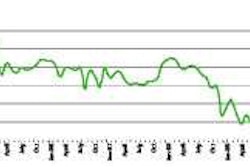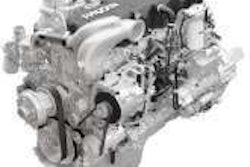 Emissions-related data is critical for fleets to measure and manage.
Emissions-related data is critical for fleets to measure and manage.Electronic control modules (ECMs) broadcast a steady stream of files and information through a vehicle’s controlled area network (CAN). Thousands of fleets are using their onboard computing and mobile communications platforms to manage some of this information — idle time, speed, mpg and engine fault codes, etc. — remotely.
The information comes in a standard format or protocol called J1708 and J1939 for heavy-duty trucks and OBD-II for light-duty vehicles. Since 1996, heavy-duty vehicle manufacturers have used the J1708 protocol. Since 2003, they have been migrating toward J1939. Several vehicle manufacturers now are using only J1939 for their 2010 model trucks.
Companies that own equipment before and after 2003, therefore, operate a “mixed” fleet in term of information capabilities. The J1939 is a newer system with a different interface structure, and it manages more data communication than J1708.
“If J1939 is present, we use this data,” says Norman Thomas, vice president of information consulting for CarrierWeb, which offers the CarrierMate onboard computing and communications platform. “If not, then we use J1708 as all larger trucks still have J1708.”
A few examples of the new data offered on J1939 include fuel level, seat belt use and new diagnostics trouble codes. “J1708 offers fuel burn and mpg, but generally not fuel level, which is desired to monitor that fuel purchases are completely inserted into the vehicle tank and to be sure none is siphoned out,” Thomas says.
Another advantage of J1939 is that it allows third-party applications in a vehicle — such as stability control and lane departure warning systems — to broadcast critical event data. This data can be picked up from the J1939 by an onboard computer.
PeopleNet, an onboard computing and mobile communications provider, captures data from a vehicle through its PerformX vehicle performance monitoring and reporting tool. The company recently enhanced PerformX with a “multibus” adapter to capture both J1708 and J1939 data.
“Having the ability to integrate to J1939 allows us to collect vehicle and third-party application data that reside on a vehicle,” says Tom Dorazio, product manager for PeopleNet’s vehicle integration products.
However, fleets that use onboard computers and mobile communications systems to manage data may not always need these added capabilities all at once.
“We’re developing technology based on market demand,” says Brad Aiken, tracking and communications business development director for TransCore. In 2008, TransCore launched CabLink as an economical in-cab communications and sensor-enabled tracking and monitoring system. “We have not seen a big demand in our market segment — small- to medium-sized fleets — for more data than the system is already providing on the J1708.”
As fleets’ information needs change, vendors will continue to develop more robust tools to help fleets incorporate more vehicle information into their daily workflow and business processes.
“We are always working with the latest technology while maintaining compatibility with the existing J1708/1939 standards,” says Tom Flies, senior vice president of product management for Xata Corp., which offers the Xatanet fleet management system. “As standards change and evolve, we want to ensure that the Xata solution is ready to support these standards as they become a reality.”
Emissions compliance
Increasingly, emissions-related data has become more important for fleets to measure and manage, and not just for cost-saving reasons. Fleets are concerned with complying with new emissions regulations.
Fleets that operate 2007 and newer vehicles can collect data about their diesel particulate filter (DPF), such as how often it is cycling. “We’re starting to see more interest in collecting DPF information,” Dorazio says.
The complexity of diagnostics increases even more for model year 2010. Vehicles have hundreds of new diagnostics codes related to new emissions requirements. CarrierWeb now is operating a beta version that reads and communicates diagnostics codes whose data definitions are included only in J1939.
“We are now working on emissions reporting as well,” Thomas says.
Emissions reporting is becoming standard in places like California. Starting this year, the California Air Resources Board is phasing in mandatory onboard diagnostics for heavy-duty vehicles. Onboard diagnostics requirements have been in place for years for light-duty vehicles, where fault codes must be produced when the ECM detects emissions that are out of compliance.
Networkfleet wirelessly monitors GPS location and engine diagnostics information directly from a vehicle’s onboard diagnostics system. Networkfleet customers can enroll light- and medium-duty vehicles in the California Continuous Testing Program, a free, remote smog check service that permits smog test exemption. Networkfleet will be able to enroll heavy-duty vehicles in the program when they become compliant with onboard diagnostics requirements.
By using the latest technology to manage vehicle performance and diagnostics information, more data does not have to mean more complexity. n
In brief
I.D. Systems (www.id-systems.com), a provider of wireless asset management solutions, acquired Asset Intelligence, a business unit of General Electric, for $15 million in cash. Asset Intelligence provides trailer and container tracking solutions.
Qualcomm Inc. (www.qualcomm.com), a provider of business-to-business wireless enterprise applications and services, announced that Trimac Transportation U.S. — the nation’s third- largest tank carrier — will upgrade its fleet to its Mobile Computing Platform 100 terrestrial series (MCP100T).
PeopleNet (www.peoplenetonline.com), a provider of Internet-based and integrated onboard computing and mobile communications systems, announced that Canadian LTL carrier Day & Ross Inc. has installed PeopleNet in its 200-truck Fastrax Division fleet.
Xata Corp. (www.xata.com), a provider of fleet optimization software and services, announced that St. Louis-based Schnuck Markets Inc., a food and pharmacy company, has selected Xata for its fleet management solution.
Prophesy Transportation Solutions (www.mile.com) added cross-docking and reconsolidation functionality to its DispatchSeries trucking software. The new features allow shipments to be reallocated independently to new loads once enroute.
Intelek Technologies Corp. (www.intelek-tech.com), developers of Web-based EDI and load gathering solutions, announced that Old Dominion Freight Line has adopted its StripMiner EDI Screen Scraper Software.













